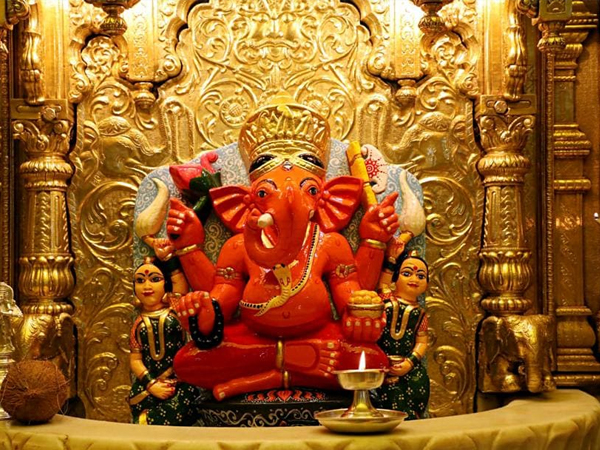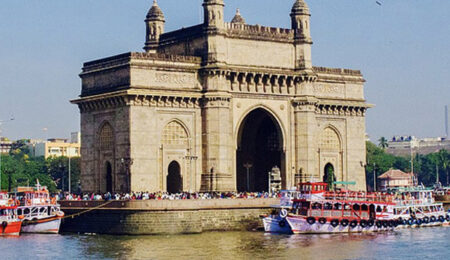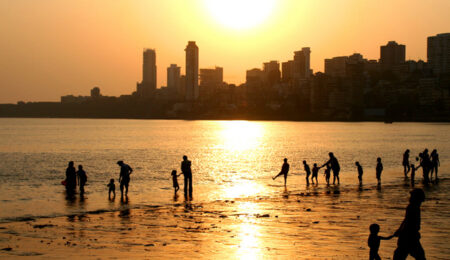Mumbai, a city that has it all, has a rich history with Hinduism and is filled with many temples all with their beautiful and unique aspects. The city is home to almost seven hundred temples, each specific to the culture of those who built them and the deity they worship. Visiting some of these temples is sure to be an eye-opening experience for any tourist and a window into Hinduism. Here’s a list of some of the temples in and around Mumbai:

Siddhivinayak Temple
One of the most famous temples in Mumbai, Siddhivinayak is dedicated to the lord of good fortune and beginnings – Lord Ganesha. In the Hindu religion, one appeases the elephant-headed god before starting any new task.
Opened in the year 1801 by Devbhai Patil and Laxmi Vithu, the temple is one of the eight Ashtvinayak temples spread across the entire state of Maharashtra. A visit to the temple will educate you about the story of this beautiful god and why he is revered deeply by Hindu people (and often by other religions as well).
The temple has an astounding statue of the lord along with his two consorts – Ridhi and Sidhi. Complete with lotus, a small ax, his favorite sweet dish – modaks, and prayer beads, the statue of this deity has four hands and looks resplendent at all times of the day.
Visit the temple to seek Lord Ganesha’s blessing. However, if you would like to see a fervent celebration of people’s beliefs, Tuesdays are the best time as a lot of tourists flock to the temple on this day and every ceremony is a little different.
Iskcon Temple
ISKCON temple is one of the most peaceful temples in Mumbai and it is spread across the entire country. Dedicated to Lord Krishna, the temple was founded to preserve the rich heritage and mythological stories behind the life of Shri Krishna and how his presence had an impact on Mahabharat, one of the greatest mythological stories to be ever told.

Started by the Acharya Bhaktivedanta Swami Prabhupada in the year 1978, the temple is perfect for spending an evening listening to the chants of Hare Krishna, and Hare Ram, and immersing in the splendor of the evening aarti and bhajans.
Moreover, the pristine white marble and beautiful architecture of the temple is another thing that will keep you here for a couple of hours. A lot of people simply come here to admire the temple’s beauty and meditate.
Mumbadevi Temple
Unlike other temples, this one is dedicated to a goddess of a particular community and not the entire religion. Goddess Mumba is the patron goddess of the Somavanshi Kshatriya, Koli, and Agri communities residing in Maharashtra. According to the legends of this community, Goddess Mumba is a powerful guardian and an incarnation of Goddess Parvati.
Located on the Bhuleshwar Road, the temple was first opened in the year 1675 and has been relocated once to its current place. Inside the temple, you will find the statue of the deity which is made of black stone with an orange face. While the statue itself doesn’t have a mouth – to symbolize earth – and is simple and beautiful, the entire altar on which it stands is decorated by the devotees.
Since Tuesday is of utmost importance in Hindu mythology, be ready to face a lot of crowds if you visit on this particular day of the week. The rush is fine on the other days.
Tip: After visiting one of the most powerful temples in Mumbai, we recommend you explore the nearby markets as well and try the Mumbadevi Jalebis.
Babulnath Temple
Another ancient temple in Mumbai, this one has located a short distance from the famous Girgaon Chowpatty Beach. Also, it is easily accessible from the Marine Lines Railway Station and attracts a good footfall of tourists and devotees. Dedicated to Lord Shiva, the temple is of great significance to the Marwari and Gujarati communities living in Mumbai.

With the beautiful interiors and intricate carvings on the walls, the temple is bound to awe-struck you. The temple is built in such a manner that it feels like you have descended on Mount Kailash – the abode of Lord Shiva.
If you wish to visit the temple on Mondays, make sure you are prepared to brace the crowd of devotees that come here because Monday is the day of Lord Shiva.
Mahalaxmi Temple
Unlike other temples in Mumbai, Mahalaxmi Temple is located next to the seashore. Unique and beautiful, the temple is dedicated to goddesses Laxmi, Saraswati, and Durga.
Each idol of the different deities is ethereal and carved out of stone. People say that all the statues are ‘swayambhu’ which means they have been carved in the most realistic form of the goddess herself. Each goddess is adorned with a golden mask as well and bathed every morning.
The temple is not only a religious place but it also has archaeological significance as several manuscripts and relics will educate you about the distinct and beautiful stories of our past.
Tip: You can visit the temple during Navratri and Diwali as both the festivals are celebrated with much pomp and gusto here.

Balaji Temple
A popular South Indian temple in Mumbai, the Balaji Temple is a replica of the Tirupati temple. Devoted to Lord Balaji, it is huge and has statues of various other deities that are worshipped by South Indians.
Some of the other temples which are housed within the premises of the complex are Lakshmi Narasimha Temple, Ramanuja Temple, Vishwaksena Temple, Padmavati Devi Temple, Hanuman Temple, and Vidya Ganapati Temple. You can either spend the entire day exploring the intricacies and details of each temple or simply take a stroll out in the garden. Click here to know more about Churches in Mumbai
The temple is beautiful and has a huge 60 feet Rajagopuram which is an integral feature of all the temples of South India.
Swaminarayan Temple
Almost 100 years old, the Swaminarayan Temple is also among the most visited temples and is integral to the people of its neighborhood. Along with the temple’s exterior, the intricate carvings and details are something that one cannot miss when praying in the halls.
Apart from the different deities and idols, the temple also has three spires on top. An audience hall is also present on the premises of the temple which has paintings on its walls. The paintings are a treat to the eyes of the visitors and devotees of Lord Krishna because it depicts his entire life.
The main deities of the temple are Narayan, Lakshmi, and Ghanshyam Maharaj. The temple has a flower market adjacent to it and sees a lot of visitors. If you want to see the temple in all its glory, visit it during Janmashtami, Mahashivratri, and Ram Navmi.
Babu Amichand Panalal Adishwarji Jain Mandir
One of the most popular and beautiful Jain temples in Mumbai, this one is stunningly beautiful and complete with intricate detailing, carvings, and even paintings. At the entrance of the temple, you will find two beautiful sculptures of elephants which is also one of the major attractions of the temple.

Built in the year 1970, the temple has similar structures of elephants prominently placed on the pillars and the ceilings. Dedicated to Adishwar, the very first Tirthankar of the Jain religion, the temple is ideal for spending a few hours.
Mini Sabarimala Temple
Mini Sabarimala, situated on a hillock surrounded by hills and valleys within the precincts of NCH Colony, Kanjurmarg (West), Mumbai, is the first ancient Ayyappa Temple outside Kerala State.
As revealed by the astrologer Shri Karuvatta Kochugovindan, there was a big Devi temple and a small Ayyappa temple at this place, where today stands the temple of Shree Mini Sabarimala. These temples were destroyed by foreign invaders.[clarification needed] The remnants of these can be seen even today. The invaders also killed the priests of these temples.
Since then the devotees used to worship Shri Ayyappa in the same dilapidated temple. Therefore after the formation of the temple trust in 1960, a need was felt to perform certain purification rites or the Dosha Parihara Kriyas like Astha Mangala Deva Prashanam. These rites were the prerequisites for starting the main construction work and re-installation of images.

Accordingly in 1980, after performing Ashta Mangala Deva Prashanam, the temple trust started the construction work as per the details in Tantra Vidhi and Thachu Shastra of Kerala. They reconstructed the main Ayyappa temple in the center and the temples of Devi Bhuvaneshvari and Shri Ganesha to their left and right respectively. Sarpakavu or the Nagadevatas were also installed in the Northeastern corner.
Punahpratishtha or the reinstallation of Shri Ayyappa image and other images made of Panchaloha was done on Pushya Nakshatra day of the Kerala Hindu calendar, in the Midhunam (June–July) month by Shri Pullamvazhi Devan Narayanan Namboothiri, Pullamvazhi illam, Haripad, the famous Vedic and Tantra scholar from Kerala.
During the year 2000, again the Ashta Mangala Deva Prashanam was performed. Various Poojas and Homams and Kalashabhishekam were performed by Mahatanthri Shri Devan Vasudevan Namboothiri.
Walkeshwar Temple
Walkeshwar temple is quite an ancient temple in the city of Mumbai. It has over time gained a heritage status for its popularity amongst pilgrims and also the beautiful architecture. It is said to be originally made by the Shares. It was built around 1050 years ago in the beautiful area of Malabar Hill. Walkeshwar is a derivation of Valuka Ishwar which means the sands of God.
You will encounter a really old structure here in the form of Venkateshwar Balaji Mandir. This particular temple is a temple from the Peshwa era and has a wooden canopy that dates back to 1789. Another structure to look out for is the Rameshwar Mandir, which is estimated to be built in 1825. All the structures though are in dire need of getting repaired and restructured.
Legends also say that this temple was made by Ram who had sent his brother to get a shiva linga with the purpose of establishing it here. Before it could be brought here, he got another one built from sand.
Visit MakeMyTrip for bookings. Also, have a look at our various monthly issues.
|
After Post Contents [Code BL 05] – Full width x 125 px |




